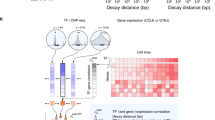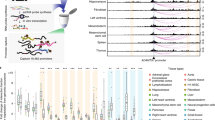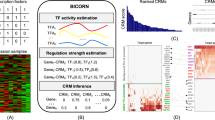Abstract
We developed the Genomic Regions Enrichment of Annotations Tool (GREAT) to analyze the functional significance of cis-regulatory regions identified by localized measurements of DNA binding events across an entire genome. Whereas previous methods took into account only binding proximal to genes, GREAT is able to properly incorporate distal binding sites and control for false positives using a binomial test over the input genomic regions. GREAT incorporates annotations from 20 ontologies and is available as a web application. Applying GREAT to data sets from chromatin immunoprecipitation coupled with massively parallel sequencing (ChIP-seq) of multiple transcription-associated factors, including SRF, NRSF, GABP, Stat3 and p300 in different developmental contexts, we recover many functions of these factors that are missed by existing gene-based tools, and we generate testable hypotheses. The utility of GREAT is not limited to ChIP-seq, as it could also be applied to open chromatin, localized epigenomic markers and similar functional data sets, as well as comparative genomics sets.
This is a preview of subscription content, access via your institution
Access options
Subscribe to this journal
Receive 12 print issues and online access
$209.00 per year
only $17.42 per issue
Buy this article
- Purchase on Springer Link
- Instant access to full article PDF
Prices may be subject to local taxes which are calculated during checkout



Similar content being viewed by others
References
Johnson, D.S., Mortazavi, A., Myers, R.M. & Wold, B. Genome-wide mapping of in vivo protein-DNA interactions. Science 316, 1497–1502 (2007).
Mardis, E.R. ChIP-seq: welcome to the new frontier. Nat. Methods 4, 613–614 (2007).
Park, P.J. ChIP-seq: advantages and challenges of a maturing technology. Nat. Rev. Genet. 10, 669–680 (2009).
Ji, H. et al. An integrated software system for analyzing ChIP-chip and ChIP-seq data. Nat. Biotechnol. 26, 1293–1300 (2008).
Kharchenko, P.V., Tolstorukov, M.Y. & Park, P.J. Design and analysis of ChIP-seq experiments for DNA-binding proteins. Nat. Biotechnol. 26, 1351–1359 (2008).
Rozowsky, J. et al. PeakSeq enables systematic scoring of ChIP-seq experiments relative to controls. Nat. Biotechnol. 27, 66–75 (2009).
Tuteja, G., White, P., Schug, J. & Kaestner, K.H. Extracting transcription factor targets from ChIP-Seq data. Nucleic Acids Res. 37, e113 (2009).
Valouev, A. et al. Genome-wide analysis of transcription factor binding sites based on ChIP-Seq data. Nat. Methods 5, 829–834 (2008).
Khatri, P. & Draghici, S. Ontological analysis of gene expression data: current tools, limitations, and open problems. Bioinformatics 21, 3587–3595 (2005).
Allison, D.B., Cui, X., Page, G.P. & Sabripour, M. Microarray data analysis: from disarray to consolidation and consensus. Nat. Rev. Genet. 7, 55–65 (2006).
Dopazo, J. Functional interpretation of microarray experiments. OMICS 10, 398–410 (2006).
Lowe, C.B., Bejerano, G. & Haussler, D. Thousands of human mobile element fragments undergo strong purifying selection near developmental genes. Proc. Natl. Acad. Sci. USA 104, 8005–8010 (2007).
Taher, L. & Ovcharenko, I. Variable locus length in the human genome leads to ascertainment bias in functional inference for non-coding elements. Bioinformatics 25, 578–584 (2009).
Ashburner, M. et al. Gene Ontology: tool for the unification of biology. The Gene Ontology Consortium. Nat. Genet. 25, 25–29 (2000).
Bejerano, G. et al. Ultraconserved elements in the human genome. Science 304, 1321–1325 (2004).
Bejerano, G. et al. A distal enhancer and an ultraconserved exon are derived from a novel retroposon. Nature 441, 87–90 (2006).
Dostie, J. et al. Chromosome Conformation Capture Carbon Copy (5C): a massively parallel solution for mapping interactions between genomic elements. Genome Res. 16, 1299–1309 (2006).
Lieberman-Aiden, E. et al. Comprehensive mapping of long-range interactions reveals folding principles of the human genome. Science 326, 289–293 (2009).
Schoenfelder, S. et al. Preferential associations between co-regulated genes reveal a transcriptional interactome in erythroid cells. Nat. Genet. 42, 53–61 (2010).
Spitz, F. & Duboule, D. Global control regions and regulatory landscapes in vertebrate development and evolution. Adv. Genet. 61, 175–205 (2008).
Huang, da W. et al. DAVID Bioinformatics Resources: expanded annotation database and novel algorithms to better extract biology from large gene lists. Nucleic Acids Res. 35, W169–W175 (2007).
Chai, J. & Tarnawski, A.S. Serum response factor: discovery, biochemistry, biological roles and implications for tissue injury healing. J. Physiol. Pharmacol. 53, 147–157 (2002).
Miano, J.M., Long, X. & Fujiwara, K. Serum response factor: master regulator of the actin cytoskeleton and contractile apparatus. Am. J. Physiol. Cell Physiol. 292, 70–81 (2007).
Ruan, J. et al. TreeFam: 2008 update. Nucleic Acids Res. 36, D735–D740 (2008).
Linhart, C., Halperin, Y. & Shamir, R. Transcription factor and microRNA motif discovery: the Amadeus platform and a compendium of metazoan target sets. Genome Res. 18, 1180–1189 (2008).
Natesan, S. & Gilman, M. YY1 facilitates the association of serum response factor with the c-fos serum response element. Mol. Cell. Biol. 15, 5975–5982 (1995).
Subramanian, A. et al. Gene set enrichment analysis: a knowledge-based approach for interpreting genome-wide expression profiles. Proc. Natl. Acad. Sci. USA 102, 15545–15550 (2005).
Cerami, E.G., Bader, G.D., Gross, B.E. & Sander, C. cPath: open source software for collecting, storing, and querying biological pathways. BMC Bioinformatics 7, 497 (2006).
Bertolotto, C. et al. Cleavage of the serum response factor during death receptor-induced apoptosis results in an inhibition of the c-FOS promoter transcriptional activity. J. Biol. Chem. 275, 12941–12947 (2000).
Poser, S., Impey, S., Trinh, K., Xia, Z. & Storm, D.R. SRF-dependent gene expression is required for PI3-kinase-regulated cell proliferation. EMBO J. 19, 4955–4966 (2000).
Lee, H.J. et al. SRF is a nuclear repressor of Smad3-mediated TGF-beta signaling. Oncogene 26, 173–185 (2007).
Chen, C.R., Kang, Y., Siegel, P.M. & Massagué, J. E2F4/5 and p107 as Smad cofactors linking the TGFbeta receptor to c-myc repression. Cell 110, 19–32 (2002).
Visel, A. et al. ChIP-seq accurately predicts tissue-specific activity of enhancers. Nature 457, 854–858 (2009).
Blake, J.A. et al. The Mouse Genome Database genotypes:phenotypes. Nucleic Acids Res. 37, D712–D719 (2009).
Wilkie, A.O. & Morriss-Kay, G.M. Genetics of craniofacial development and malformation. Nat. Rev. Genet. 2, 458–468 (2001).
Capdevila, J. & Izpisúa Belmonte, J.C. Patterning mechanisms controlling vertebrate limb development. Annu. Rev. Cell Dev. Biol. 17, 87–132 (2001).
Kretzschmar, M. & Massagué, J. SMADs: mediators and regulators of TGF-beta signaling. Curr. Opin. Genet. Dev. 8, 103–111 (1998).
Bult, C.J., Eppig, J.T., Kadin, J.A., Richardson, J.E. & Blake, J.A. The Mouse Genome Database (MGD): mouse biology and model systems. Nucleic Acids Res. 36, D724–D728 (2008).
Niswander, L. Pattern formation: old models out on a limb. Nat. Rev. Genet. 4, 133–143 (2003).
Zhou, C.J., Borello, U., Rubenstein, J.L. & Pleasure, S.J. Neuronal production and precursor proliferation defects in the neocortex of mice with loss of function in the canonical Wnt signaling pathway. Neuroscience 142, 1119–1131 (2006).
Wurst, W. & Bally-Cuif, L. Neural plate patterning: upstream and downstream of the isthmic organizer. Nat. Rev. Neurosci. 2, 99–108 (2001).
Park, C.C. et al. Fine mapping of regulatory loci for mammalian gene expression using radiation hybrids. Nat. Genet. 40, 421–429 (2008).
Chen, X. et al. Integration of external signaling pathways with the core transcriptional network in embryonic stem cells. Cell 133, 1106–1117 (2008).
Kent, W.J. et al. The human genome browser at UCSC. Genome Res. 12, 996–1006 (2002).
Hsu, F. et al. The UCSC Known Genes. Bioinformatics 22, 1036–1046 (2006).
The ENCODE Project Consortium Identification and analysis of functional elements in 1% of the human genome by the ENCODE pilot project. Nature 447, 799–816 (2007).
Lettice, L.A. et al. A long-range Shh enhancer regulates expression in the developing limb and fin and is associated with preaxial polydactyly. Hum. Mol. Genet. 12, 1725–1735 (2003).
Maston, G.A., Evans, S.K. & Green, M.R. Transcriptional regulatory elements in the human genome. Annu. Rev. Genomics Hum. Genet. 7, 29–59 (2006).
Levings, P.P. & Bungert, J. The human beta-globin locus control region. Eur. J. Biochem. 269, 1589–1599 (2002).
Spitz, F., Gonzalez, F. & Duboule, D. A global control region defines a chromosomal regulatory landscape containing the HoxD cluster. Cell 113, 405–417 (2003).
Acknowledgements
We thank M. Sirota for an early survey of ontologies, F. Sathira for developing an intermediary core calculation engine, T. Capellini for critical reading of the manuscript, M. Davis and S. Gutierrez for system administration and the communities of ontology developers and curators for providing invaluable data sources. C.Y.M. is supported by a Bio-X graduate fellowship. M.H. is supported by a German Research Foundation Fellowship (Hi 1423/2-1) and the Human Frontier Science Program (fellowship LT000896/2009-l). S.L.C. is a Howard Hughes Medical Institute Gilliam Fellow. A.M.W. is supported by a Stanford Graduate Fellowship. G.B. is a Packard Fellow, Searle Scholar, Microsoft Research Faculty Fellow and an Alfred P. Sloan Fellow. Research was also supported by an Edward Mallinckrodt, Jr. Foundation junior faculty grant and US National Institutes of Health grant 1R01HD059862 to G.B.
Author information
Authors and Affiliations
Contributions
C.Y.M. developed the core calculation engine, processed ontologies, analyzed data sets and co-wrote the manuscript. D.B. designed and developed the web application. M.H. added key ontologies and calculated ontology statistics. S.L.C. performed and wrote the SRF analysis. B.T.S. contributed to data set analysis and manuscript writing. A.M.W. guided website design and wrote user documentation. G.B. and C.B.L. devised the different enrichment tests and developed early core calculation engines. G.B. supervised the project and co-wrote the manuscript. All authors edited the manuscript.
Corresponding author
Ethics declarations
Competing interests
The authors declare no competing financial interests.
Supplementary information
Supplementary Text and Figures
Supplementary Note, Supplementary Figures 1–4 and Supplementary Tables 1–46 (PDF 5181 kb)
Rights and permissions
About this article
Cite this article
McLean, C., Bristor, D., Hiller, M. et al. GREAT improves functional interpretation of cis-regulatory regions. Nat Biotechnol 28, 495–501 (2010). https://doi.org/10.1038/nbt.1630
Published:
Issue Date:
DOI: https://doi.org/10.1038/nbt.1630
This article is cited by
-
MethScore as a new comprehensive DNA methylation-based value refining the prognosis in acute myeloid leukemia
Clinical Epigenetics (2024)
-
Chromatin accessibility and cell cycle progression are controlled by the HDAC-associated Sin3B protein in murine hematopoietic stem cells
Epigenetics & Chromatin (2024)
-
Modeling methyl-sensitive transcription factor motifs with an expanded epigenetic alphabet
Genome Biology (2024)
-
Quiescence enables unrestricted cell fate in naive embryonic stem cells
Nature Communications (2024)
-
3D Enhancer–promoter networks provide predictive features for gene expression and coregulation in early embryonic lineages
Nature Structural & Molecular Biology (2024)



